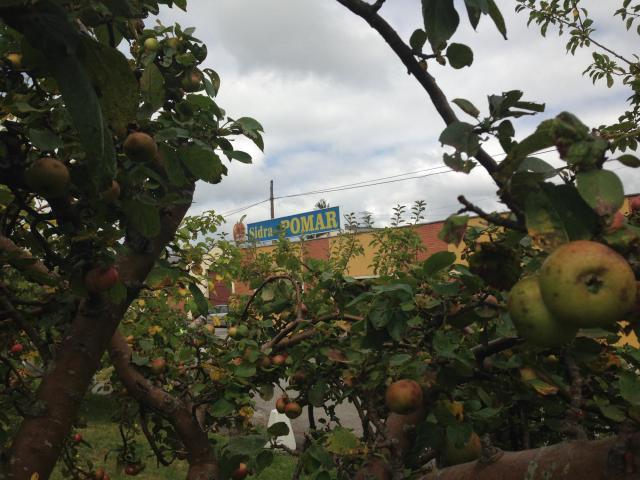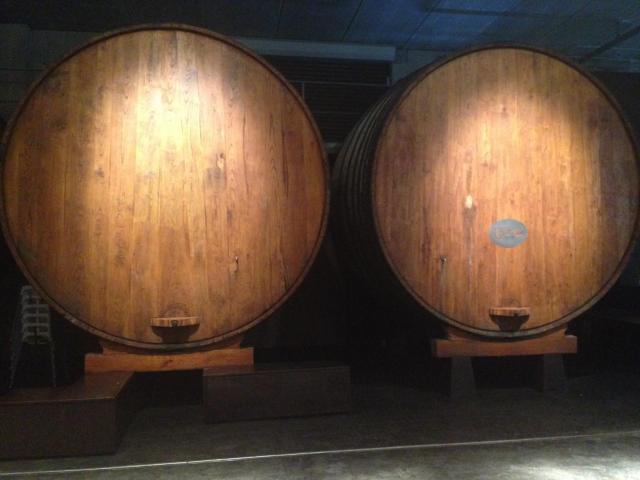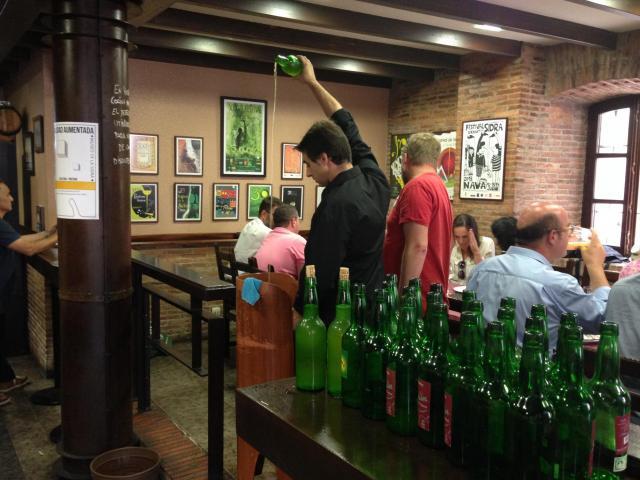Chicagoist's Cider(s) Of The Month: Spain's Ciders
By Staff in Food on Oct 23, 2014 4:30PM

Photo by Brian Rutzen
I recently returned from a 10-day sojourn in northern Spain visiting cideries and orchards, a place where the oldest continuous cider culture in Europe still thrives. Many people outside of the region would never know how big a role cider plays in the daily life. Indeed, you would most likely never order a cider, or "sidra," in Madrid, Barcelona or Sevilla. However, along Along the north coast of Spain it is so deeply entwined into the culture as to be almost invisible- that is, because it is everywhere, you don't even notice it.
I traveled with cider makers from all over the US, as well as esteemed cider authors from the US and Canada and a photographer from England. We would visit two or three cider makers each day, which meant we usually had a glass in our hand by 10:30am (It is a good thing we are professionals).
There are two regions where cider is made and consumed in northern Spain. One is the Basque Country, near the border with France along the Atlantic coast. All of the activity is focused in the small town of Astigarraga, just outside of San Sebastián. For centuries, apples have been harvested and fermented into a bright alcoholic beverage that is served at every meal. You might have beer, you might have wine, but you will also have cider. It is a chief component of the food culture in this very small, localized region.

Barrels of cider in Asturias (Photo by Brian Rutzen)
Travel west along the coast, and you come to the state of Asturias in northern Spain. It is a region the size of Connecticut, and yet there are over 90 cider producers in and around the capital city of Gijon. That is a lot of producers for such a small region. What is more amazing is that 90 percent of the cider produced is consumed right there in Asturias. Everybody drinks it. Young, old, men, women. Everyone. Empty bottles are stacked several feet high in plastic crates, waiting to be returned and refilled. Every third bar is a "sideria" that specializes in cider. People are pouring a new glass for their friends around every corner. The cobblestone streets are literally flowing with cider, which are then hosed down each evening.

The traditional method of pouring cider in Spain (Photo by Brian Rutzen)
Speaking of pouring: the method of serving sidra is critical to the cultural experience as well as the flavor of the cider itself. Traditional (natural) Spanish cider is unfiltered and unpasteurized. It is fermented with wild yeasts and left un-carbonated in the bottle. Before opening a bottle, you turn it upside down to dislodge the sediment that has settled at the bottom. Then swirl it around, which turns the clear cider cloudy with the remaining yeasts. Uncork the green 750 ml bottle and raise it above your head. At the same time, place the glass in your other hand below your waist. this puts a good 3-4 feet of distance between the bottle and glass. Slowly, turn the bottle sideways and let the cider fall from the opening to create a steady flow that hits the mouth of your glass below.
This is no easy task. It takes practice. If you order from a sideria there are professional pourers, or escanciadors, who have mastered the art. Of course, you can always give it a try yourself- preferably outside where you are free to make a mess! As the cider falls, it hits the side of the thin walled glass below with a great force. This aerates the formerly still cider and brings the golden liquid to life. All of the yeast and apple sediment froths up and creates a slight foamy lacing in the bottom of your glass. This is important. You only pour enough cider to fill the bottom 1/4 of the glass; this is a single serving size pour. The escanciador hands you the glass, which you then raise to your lips and sip consistently until finished. You do not slam it down, but nor is this a savoring experience. You do not smell the glass, sip a bit, put it down and then take another. You drink until the serving is done. Then you hand it back to the gentleman behind the bar who will pour another (in the same glass) and hand it to your friend. You do this again and again until the bottle is gone. A group of four people will finish a 750ml bottle in less than ten minutes (probably more like five!).
So, what does it taste like? It is almost certainly unlike any cider you have ever tried before. Bright citrus flavors accompany intense floral notes that come across like a sour beer. There is a salty, almost brine like quality to the drink, that is balanced by the citrus fruit and yeast esters. While there is some volatile acidity present, it ought not to dominate the experience. It is not for everyone, but those who like it - will love it.
Some of the best ciders available locally include Trabanco and Gobernador (from Asturias) and Isategi and Sarasola (from the Basque region). Sidra Natural is lively, and pairs well with rich cheeses, seafood and charcuterie. Serve it cool, but not too cold - around 50-52 degrees Fahrenheit. More importantly, find a way to aerate the pour. Many bottles are sold with special aerating pourers that allow air to enter from both directions. Raise the bottle as high above your glass as you are comfortable, and let the cider stream flow. This should create a lively dance and allow these unique flavors to shine. Finally, share with the people around you. Perhaps some of the magic inside the bottle is only released when you are committed to pouring for your friends. Just hand them a glass, look them in the eye with a smile and say, "Salud."
Look for Spanish cider at retailers with large cider selections such as LUSH Wine and Spirits or Binny's, as well as some of Chicago's best Spanish restaurants like Vera (1023 W. Lake St.) and Salero (621 W. Randolph St.).
By Brian Rutzen